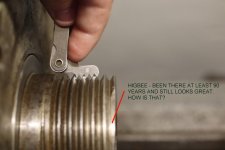How to install the app on iOS
Follow along with the video below to see how to install our site as a web app on your home screen.
Note: This feature may not be available in some browsers.
You are using an out of date browser. It may not display this or other websites correctly.
You should upgrade or use an alternative browser.
You should upgrade or use an alternative browser.
How to Measure Tapping Cutters?
- Thread starter drcoelho
- Start date
- Replies 9
- Views 2,283
DMF_TomB
Diamond
- Joined
- Dec 13, 2008
- Location
- Rochester, NY, USA
.So I inherited a large collection of taps of various sizes, most of them not labelled, and no marking. Is it possible to reliably determine the size of each? If so, what technique?
thread pitch gage and use outside micrometer. often taps might measure big on outside dia, common to measure larger taps .002" to .010" bigger than normal diameter. used and unlabeled taps not of much value. oversize taps are often only .005" oversize and would be hard to tell. they also have GO/NOGO thread pitch gages. by tapping a hole you could tell if tap is oversize by screwing into tapped hole
.
thread pitch gauge - Google Search
Lewie
Cast Iron
- Joined
- Jun 7, 2018
- Location
- Albuquerque NM
I would guess he means a drill bit . :-) But from a "cast iron" person who knows :-)
...lewie...
...lewie...
SigurdACVW
Aluminum
- Joined
- Aug 16, 2013
- Location
- IL
If it's a 3-flute tap, you might have to get a little creative depending on what tools you have at your disposal. If you're in a shop environment, you could mic the shank, note the value, then set it up in a v-block on a surface plate and indicate the top of the shank and measure the distance from the top of the shank to the surface plate with joblocks. Then, indicate a flute at its highest point and measure down to the surface plate with joblocks. Then, use the two measurements and the diameter of the shank to math out the major diameter of the tap.
If you have a shadowgraph/optical comparator, that makes it easier.
If you have a shadowgraph/optical comparator, that makes it easier.
I would guess he means a drill bit . :-) But from a "cast iron" person who knows :-)
...lewie...
I meant "tap"...be gentle, I may be ignorant but I'm not stupid

The first thing I would check is the pitch of the threads. This will (in most cases) determine if it's metric or imperial.
Then check the diameter and you're golden. Just compare it to any online thread chart.
One thing to note, is that the diameter will most likely be a tad bit larger than the nominal size. For instance a 3/4-10 tap might measure .755" diameter. And of course the pitch would measure .100" from one thread to another.
Then check the diameter and you're golden. Just compare it to any online thread chart.
One thing to note, is that the diameter will most likely be a tad bit larger than the nominal size. For instance a 3/4-10 tap might measure .755" diameter. And of course the pitch would measure .100" from one thread to another.
johnoder
Diamond
- Joined
- Jul 16, 2004
- Location
- Houston, TX USA
SigurdACVW
Aluminum
- Joined
- Aug 16, 2013
- Location
- IL
Buy a flock of differing nuts and see if any taps screw into which nuts like they were made to do that
But I would be segregating them in to lots with the same pitch first
Here is a pitch gage in use
Along the lines of this suggestion is to find a Home Depot or Lowe's or something similar and see if they have one of those checking gages in the hardware aisle with the different screws and nuts already installed. Take your taps and have at it.
Similar threads
- Replies
- 9
- Views
- 330
- Replies
- 20
- Views
- 689


